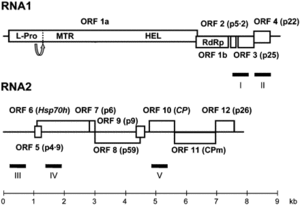Chicken Anemia Virus and Depression: Difference between revisions
No edit summary |
No edit summary |
||
| Line 15: | Line 15: | ||
==Description and Significance== | ==Description and Significance== | ||
<br> | |||
[[Image:VIR53661-1.gif|thumb|300px|right| Genomic structure of RNA1 and RNA2 in Spanish isolate CYSDV-AILM. [http://vir.sgmjournals.org/cgi/content/full/86/3/815].]] | |||
<br> | <br> | ||
Chicken Anemia Virus (CAV), is the cause of a disease refered to as called Blue Wing Disease, Infectious Chicken Anemia, and Chicken Anemia Agent. This virus affects both meat and egg-type chickens, though it is more rampid among commercially produced chickens. Disease most often occurs and is most lethal during the first three weeks of life. Chickens of any age may be infected via oral and respiratory routes, but their mature immune systems are much more resistant. An individual infected with CAV will be a life-long carrier. Symptoms of CAV include pale extremeties such as wattle, comb and legs, anorexia, weakness, cyanosis, lethargy and sudden death. Neurological symptoms include dullness, depression, and paresis. Severely sick birds may die within 2 to 4 weeks, while survivors are usually stunted. CAV suppresses the immune system and makes survivors highly susceptible to other infections.<br><br> | Chicken Anemia Virus (CAV), is the cause of a disease refered to as called Blue Wing Disease, Infectious Chicken Anemia, and Chicken Anemia Agent. This virus affects both meat and egg-type chickens, though it is more rampid among commercially produced chickens. Disease most often occurs and is most lethal during the first three weeks of life. Chickens of any age may be infected via oral and respiratory routes, but their mature immune systems are much more resistant. An individual infected with CAV will be a life-long carrier. Symptoms of CAV include pale extremeties such as wattle, comb and legs, anorexia, weakness, cyanosis, lethargy and sudden death. Neurological symptoms include dullness, depression, and paresis. Severely sick birds may die within 2 to 4 weeks, while survivors are usually stunted. CAV suppresses the immune system and makes survivors highly susceptible to other infections.<br><br> | ||
Revision as of 21:48, 19 September 2012
A Viral Biorealm page on the family Chicken Anemia Virus and Depression
Baltimore Classification
Group II: single-stranded DNA viruses
Higher order categories
Kingdom: Virus
Family: Circoviridae
Genus: Circovirus
Species: Chicken Anemia Virus (CAV)
Description and Significance

Chicken Anemia Virus (CAV), is the cause of a disease refered to as called Blue Wing Disease, Infectious Chicken Anemia, and Chicken Anemia Agent. This virus affects both meat and egg-type chickens, though it is more rampid among commercially produced chickens. Disease most often occurs and is most lethal during the first three weeks of life. Chickens of any age may be infected via oral and respiratory routes, but their mature immune systems are much more resistant. An individual infected with CAV will be a life-long carrier. Symptoms of CAV include pale extremeties such as wattle, comb and legs, anorexia, weakness, cyanosis, lethargy and sudden death. Neurological symptoms include dullness, depression, and paresis. Severely sick birds may die within 2 to 4 weeks, while survivors are usually stunted. CAV suppresses the immune system and makes survivors highly susceptible to other infections.
A particularly interesting aspect of Chicken Anemia Virus is it's symptom of depression. The presence of depression in non-human mammals is disputed, and hardly found in animals beyond mammals. However, CAV is consistently found to incite behaviors indicative of depression. CAV presents the possibility of learning about avian depression. To confirm mental depression outside of the class mammalia may lead to a greater understanding of the affliction. Because of their abundance, ease of obtaining, and our comprehensive knowledge of them, common chickens would be a great model system for research regarding depression.
Genome Structure

Virion Structure of a ______virus
The CVA virion is a non-enveloped icosahedral structure 23-25nm in diameter.
This virus is especially hearty, as it has proven resistant to high temperature, acidic pH, chloroform, and commercial disinfectants. It can be destroyed with hypochlorite and iodophor.
Reproductive Cycle of a ______virus in a Host Cell
Viral Ecology & Pathology
References
"Chicken Anemia Virus Disease." WikiVet. PUBLISHER. 17 August 2012. Web. 13 September 2012. <http://en.wikivet.net/Chicken_Anaemia_Virus_Disease>
Rosenberger, J. K. and Cloud, S. S. "Chicken Anemia Virus." Poultry Science. 1998. 77:1190-1192.
Page authored by Ellen Gaglione for BIOL 375 Virology, September 2010
